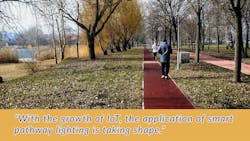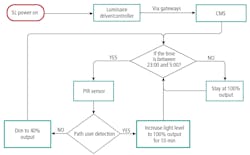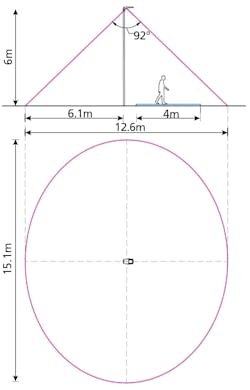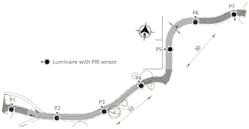In roadway and outdoor area lighting applications, switching to highly efficient LEDs alone could generate as much as 50% energy savings. However, the value of controls alongside LED upgrades has not yet been fully realized.
As LED technology matures and merges with telecommunications and Big Data, modern lighting has and will continue to make great strides toward intelligent operation. Cities around the world are in the process of building their smart grids on top of the Internet of Things (IoT). Street lighting will continue to become integrated with the IoT. Due to established and ubiquitous infrastructure, light poles will naturally become the backbone of the IoT network, enabling reliable signal coverage and connectivity over cities.
A study by Auckland Transport estimated that an additional 15% energy savings is possible through integrating LEDs in a smart lighting network. In Scotland, business cases for smart lighting have proposed to dim lights by 50% between 11:00 PM and 6:00 AM to better manage municipal lighting energy consumption while preserving public safety. Yet another study in Ireland proved that a city-wide central management system (CMS) would enable a 15% savings in non-routine maintenance costs, which includes replacing lights damaged by severe weather and vandalism or lights that unexpectedly fail.1
Like any other system of IoT devices, lighting and controls must be designed into a network architecture for successful smart city implementations. In this article, we will examine a local infrastructure project developed for the city of Christchurch in New Zealand as an example of connected outdoor lighting that operates and communicates over a network to realize the benefits of smart functionality in a municipal area.
Neighborhood Area Network topology
A Neighborhood Area Network (NAN) normally consists of three components: coordinator, router, and end device(s).
A coordinator is the most capable and expensive device that forms the root of a network.2 It stores, receives, and forwards messages to other devices in the network, connecting other nodes in the subnet to the CMS. Like a relay, the router passes on data between other devices and extends the network reach. End devices listen and respond to the parent node, but they typically do not relay data from other devices.2
Depending on the project needs and application, the NAN can be structured with several topologies, including tree, star, and mesh. For a quick reference on topology definitions, visit the glossary of the Alliance for Telecommunications Industry Solutions (ATIS).
In comparison with tree and star topologies, a mesh network has several advantages. It is more reliable and robust as the decentralized structure reduces the risks of system damage or breakdown. It also avoids the heavy concentration of data traffic at a single coordinator or path route. Furthermore, a mesh network can “self heal”: If a coordinator or router fails, an alternative route will be automatically established without disabling other nodes. Finally, the mesh network can be easily expanded without disrupting current users or requiring upgrades to established infrastructure.
Mesh network architecture
The city of Christchurch has adopted a mesh network to build out its IoT scheme, using wireless IPv6 technology with a radio frequency (RF) wavelength of 917 MHz for communications. The RF layer is based upon IEEE 802.15.4g standard, which is supported by the Wi-SUN alliance (read more on this and other outdoor lighting/smart city standards in a prior LEDs Magazine feature). Other protocols or media such as wired power line communications (PLC), Wi-Fi, Zigbee, and cellular could also be used depending on future project requirements. Fig. 1 illustrates the architecture of the mesh network utilized in Christchurch’s latest pathway lighting project.
For the Christchurch network, a specially developed CMS software and service package efficiently handles all data collection and facility management tasks. It provides a platform for continuous monitoring and analysis of system operational and safety conditions as well as energy consumption data.
To date, there are 10 gateway devices (also known as access points or APs) deployed in Christchurch. The gateways function as coordinators. They link end devices with utility back-office systems, providing communications to and from the end devices. They also transport information through multiple routers. Gateways can communicate directly with end devices including the cameras, sensors, meters, and so on when they are in range. For those devices that are out of range, a gateway can communicate indirectly by using one or more routers.3
A luminaire controller (LC) performs the router function for its associated luminaire and devices while extending the network range. RF signal strength can decrease between transmitter and receiver due to interference or obstructions such as foliage, buildings, and terrain. LCs receive signals from other network devices and retransmit those signals at enhanced strength.
Operational example of pathway lighting
When street lighting power is turned on via a ripple relay or photocell, the LC will communicate with the CMS through the gateways. The preset time judgment condition will be checked. Fig. 2 illustrates a typical lighting dimming profile applied to Christchurch’s dedicated pathways. If the time fits in the range of 23:00–05:00, dimming will be enacted; otherwise, the pathway lighting will remain at full output.
In dimming mode, if the passive infrared (PIR) motion sensor does not detect any pedestrian or cyclist presence, the light level will remain at 40% of the designed output. (The majority of Christchurch’s pathways were designed to PP3 lighting standard. The PP3 and PP4 levels are outlined in the Australian AS1158.3.1 standard that defines recommended outdoor lighting levels. Calculations suggest that 40% of original output will drop the lighting level to the next compliant level of PP4.) When a path user is detected, the luminaires will be activated with full output for a specified amount of time — for example, 10 minutes. Moreover, “fade-in” and “fade-out” patterns are used to minimize any “blinking” annoyance to local residents.
In the near future, the street-light power network will be converted to 24/7 supply. At that point, lighting on/off operation will be governed by the CMS. The LCs will stand by and “listen” to the CMS periodically to carry out orders, which are not limited to dimming but also involve transmitting data regarding ambient temperature, environmental noise, air pollution, faulty status and so on.
Sensor layout for pathway lighting
The shared pathways in Christchurch are usually 4m wide, and lighting pole height for the path ranges from 5 to 7m.4 Motion sensors have been selected with a detection range that effectively covers the path and its surrounding areas, while not picking up movements from the adjacent private properties.
Fig. 3 shows the sensor detection range. The selected sensor provides a sensing field cone covering a spread of 92°×102°, with a maximum sensing radius of 12m. Path location, terrain, and other physical features vary dramatically, which means sensor location, spacing, and control schemes must be examined case by case, to avoid a sensing “blind spot.”
Fig. 4 shows a path with limited access — pedestrians/cyclists may only enter the path at certain spots. In this case, only the key entry and exit points need to be equipped with a sensor to detect the presence of path users.
Once users are detected at any of these points, the LCs will send messages back to the CMS via the gateways, then the CMS will dispatch the orders to bring the lighting of the entire path to the full output for a defined period of time, which would allow the path user to finish the entire trip. The journey time can be determined by dividing the path length by nominal walking speed. As per studies undertaken in Australia, the walking speed used for determining the pedestrian walk time and pedestrian clearance time is usually 1.2 m/s. For areas with a greater number of slower pedestrians, a clearance walking speed of 1.0 m/s would also be appropriate.5
In Fig. 5, we see a fully open path that users may access at any point. For this layout, the best solution is to install a sensor on every single pole or luminaire. Each sensor would bring only its associated luminaire to full illumination output. If safety is of greater concern, an advanced scheme may allow two lighting spans ahead of the travel direction to be activated via CMS as the sensors detect movement along the path.
Conclusion
With the growth of IoT, the application of smart pathway lighting is taking shape. Lighting control is a vital part of human-centric outdoor lighting design. The potential and advantages of smart technology implementations should be explored in modern lighting designs to help create a safer, more convenient, and energy-efficient night-time environment.
ACKNOWLEDGMENTS
The author would like to extend his deepest gratitude to Mr. Geoff English from Christchurch City Council, for his valuable advice on the mesh network section; and to the lighting teams from Powerplant Project Services (Melbourne) and Connetics ltd. (Christchurch) for their kind support of this study.
REFERENCES
1. R. Chau and M. Punn et al., “Smart lighting feasibility study,” Public Lighting Group, Arup Australia (2017).
2. S. Shams, “Mesh networks for lighting control applications,” Lighting Art & Sci., 32–36 (June/July 2016).
3. Silver Spring Networks, Solution and Product Overview, 42–43 (2015).
4. Y. Zhu, “The ‘blind spot’ in pathway lighting mounting height selection,” Lighting Art & Sci., 22–25 (February/March 2021; issue no longer available).
5. L. Truong et al., “Walking speeds for timing of pedestrian walk and clearance intervals,” 40th Australasian Transport Research Forum (ATRF 2018).
Get to know our expert
YUNYU (CLAUDE) ZHU is a senior lighting engineer with Powerplant Project Services in Melbourne. He has specialist expertise in street, cycleway, car park, and flood lighting. Zhu holds a bachelor's degree in optical science from China's Northwest University and a master's degree in lighting from Queensland University of Technology. He has been working in the lighting industry since 2009, leaving his footprint in China, Saudi Arabia, New Zealand, and Australia. In addition to lighting, Zhu has a deep interest in science, philosophy, and nature.

![FIG. 1. A mesh network architecture is used to support smart outdoor pathway lighting using a central management system (CMS) to communicate and control luminaires and other end devices via gateways. [Image credits: All images courtesy of Yunyu (Claude) Zhu.] FIG. 1. A mesh network architecture is used to support smart outdoor pathway lighting using a central management system (CMS) to communicate and control luminaires and other end devices via gateways. [Image credits: All images courtesy of Yunyu (Claude) Zhu.]](https://img.ledsmagazine.com/files/base/ebm/leds/image/2021/10/2110LED_zhu_01.61605133d76eb.png?auto=format,compress&fit=max&q=45&h=284&height=284&w=250&width=250)








